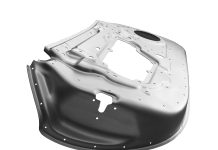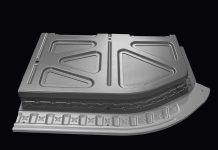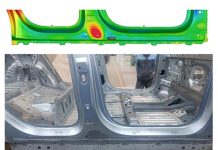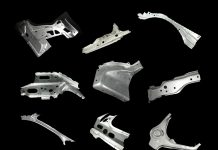Plenty of Sheet Metal Forming Opportunity Says Andrew Halonen, Mayflower Consulting LLC!
I
n this guest post, Andrew Halonen, President of Mayflower Consulting, LLC, presents a valuable study on the lightweighting of critical safety components manufactured for wheel-end and suspensions. Suspension arms are made from many materials & processes to meet the same specification, yet an OEM reports that those produced from sheet metal stampings deliver substantially better economics. The parts in the study comprise 20% of the vehicle weight, showing a perfect opportunity for economical lightweighting with stampings.
 With the increasing CAFÉ 2025 fuel economy targets, automobile manufacturers are using a number of methods to improve fuel economy. Engine downsizing, turbo systems, electrification, aerodynamics and lightweighting are among the most effective methods. In 2017, there was considerable news on electrification; will it gain market acceptance and if so, how will it affect the material selection? Logically, range-limited vehicles will benefit most from lightweight materials, yet because they are adding expensive batteries and related operating systems; they need to carefully manage costs.
With the increasing CAFÉ 2025 fuel economy targets, automobile manufacturers are using a number of methods to improve fuel economy. Engine downsizing, turbo systems, electrification, aerodynamics and lightweighting are among the most effective methods. In 2017, there was considerable news on electrification; will it gain market acceptance and if so, how will it affect the material selection? Logically, range-limited vehicles will benefit most from lightweight materials, yet because they are adding expensive batteries and related operating systems; they need to carefully manage costs.
Let’s look at the safety critical components in the wheel-end and suspensions — what materials are used? What processes are used? Well, we wanted to find out, so we crawled underneath 89 vehicles to see for ourselves. These components comprise of roughly 20% of the total vehicle weight, yet they get little attention in the automotive press, and across the material consortiums promoting their respective materials and process innovations. These components include wheels, brake calipers, brake discs, steering knuckles and suspension arms and links.
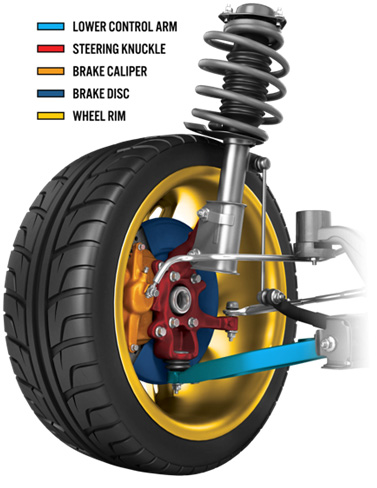 Before embarking on this study, I had the impression that most suspension arms were solid – cast or forged, aluminum or iron. Boy, was I wrong!
Before embarking on this study, I had the impression that most suspension arms were solid – cast or forged, aluminum or iron. Boy, was I wrong!
The trade study of 89 vehicles over 16 brands is organized by market segments that it includes 5 performance cars, 24 cars, 38 cross-overs/SUVs, 15 pickups, 4 minivans and 3 work vans. Let’s take a deep dive into the car data from the following vehicles that were found on dealership lots in the summer of 2017.
Safety Components in Trade Study
The safety critical components in the wheel-end and suspension systems include the following:
- Wheels
- Brake discs
- Brake caliper
- Steering knuckle
- Suspension arms
Wheels, Brake Discs, Brake Calipers, Steering Knuckles
These components are not made by sheet products. Aluminum castings dominate automotive wheel manufacturing. Steering knuckles are a mix between aluminum castings and iron castings, yet some are aluminum forgings especially when an OEM is seeking double-digit elongation. Brake calipers are predominantly gray iron despite the 2.3kg weight savings delivered by cast aluminum on the overweight front axles. Brake discs are mostly gray iron, yet a few premium vehicles integrate aluminum or steel “hat” in the center to reduce the weight by 15-20%.
Suspension Arms
Look no further than the suspension, specifically the lower control arms (LCA) on cars, for another multi-material story. Did you know that there are six different ways to produce a lower control arm on a small sedan? And, we found seven different ways to produce the rear upper control arms (UCA)!
Looking at a subset of six cars with curb weights ranging from 2,246 pounds to 3,969 pounds (1018-1800 kg), the study found forged steel, welded steel, stamped steel, forged aluminum, cast aluminum, and a unique product on a rear LCA, extruded aluminum with a cover. One of the six cars is a plug-in hybrid electric vehicle (PHEV); it has steel suspension arms, a mix of aluminum and iron on the brake calipers & steering knuckles, and it has a cast aluminum subframe.
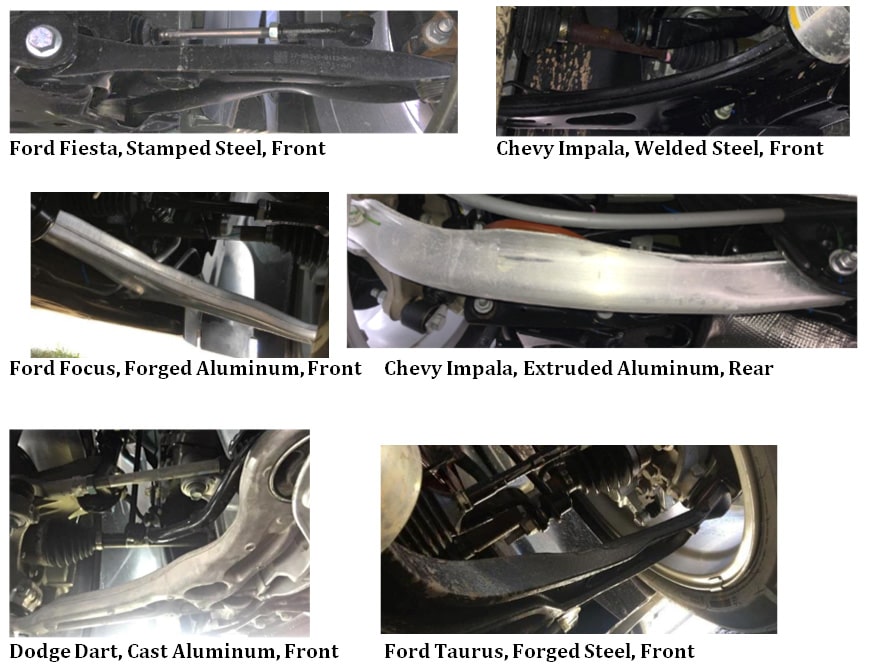
Source: Mayflower Consulting, LLC
Most of these cars fall beneath a gross vehicle weight of 4,700 pounds (2,132 kg), which is about the maximum weight for a front suspension using MacPherson strut (no upper control arm); heavier vehicles with independent suspension use a double wishbone (upper & lower control arms).
On the upper control arms, we found seven different material & process combinations with the addition of ductile iron, which was not found on the lower control arms. See the summary of materials & processes on the 24 car models below.
Suspension Material & Process Selection of Upper Control Arms (UCA) and Lower Control Arms (LCA) on 24 Cars

*N/A pertains to suspensions without listed component.
What does the future hold for suspension arms?
The suspension arms represent a myriad of materials and technologies spanning the cost versus weight trade-offs. I think the future is bright for stamped and/or welded sheet product control arms for these reasons:
- When this data was presented at the Lightweighting World Expo in Novi MI in October, I asked an OEM manager if he was surprised to see so many steel clamshell suspension components? He said, “No. The weight is close to aluminum forgings at about one-third the price.”
- The market is gearing up for electrification, yet the battery system is extremely expensive. Autonomy is expensive. These market demands put more cost pressure on other components, and clamshell steel is low cost.
- The Tesla S sedan is mostly aluminum, yet the front upper control arm is clamshell steel. If it makes sense on a premium EV, it really ought to be the material of choice on an affordable EV.
- The Chevy Camaro rear linkages were simple steel stampings. With the high strength “Gen3” steels coming, will we see more wheel-ends like this Camaro?
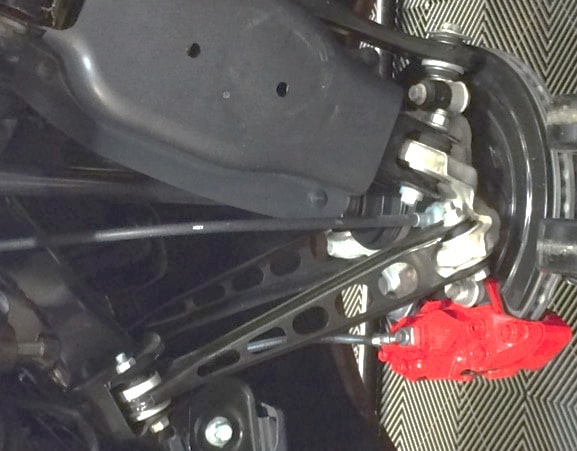
Image: Chevy Camaro Rear Suspension Links
ABOUT THE AUTHOR
 Andrew Halonen is President of Mayflower Consulting, LLC, a lightweighting consultancy that provides strategic marketing, market research and business development for high tech clients in automotive, defense and commercial trucking. Andrew works with castings, composites, additive manufacturing and new material development programs.
Andrew Halonen is President of Mayflower Consulting, LLC, a lightweighting consultancy that provides strategic marketing, market research and business development for high tech clients in automotive, defense and commercial trucking. Andrew works with castings, composites, additive manufacturing and new material development programs.
Mayflower Consulting LLC produced a self-funded trade study on the materials and design of suspension and wheel-end components on 89 vehicle spanning six market segments. More information is available HERE.






